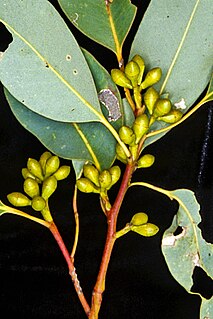
Corymbia dallachiana commonly known as Dallachy's ghost gum or Dallachy's gum, is a species of tree that is endemic to Queensland. It has smooth bark, lance-shaped or curved adult leaves, flower buds usually in groups of three, white flowers and cup-shaped, cylindrical or barrel-shaped fruit.

Corymbia henryi, commonly known as the large-leaved spotted gum, is a species of small to medium-sized tree that is endemic to north-eastern Australia. It has smooth, mottled bark, lance-shaped adult leaves, flower buds in groups of three, white or lemon yellow flowers and barrel-shaped to urn-shaped fruit.
Corymbia papuana, commonly known as ghost gum, is a species of evergreen tree native to New Guinea, some Torres Strait Islands and the northern part of the Cape York Peninsula in Australia. It has smooth whitish bark, lance-shaped adult leaves, flower buds in groups of three or seven, creamy white flowers and barrel-shaped or urn-shaped fruit.
Eucalyptus limitaris is a species of tree or mallee that is endemic to north-west Australia. It has rough, flaky or fibrous bark on the trunk and branches, lance-shaped to curved adult leaves, flower buds in groups of seven on a branching peduncle and conical to barrel-shaped or cup-shaped fruit.

Corymbia bloxsomei, commonly known as yellowjack, yellow jacket or yellow bloodwood, is a species of tree that is endemic to inland, south-eastern Queensland. It has thick, rough scaly bark on the trunk and larger branches, lance-shaped or curved adult leaves, flower buds in groups of seven, nine or eleven, creamy white to pale yellow flowers and barrel-shaped, urn-shaped or spherical fruit.
Corymbia brachycarpa is a species of tree that is endemic to central Queensland. It has rough, tessellated bark on the trunk and branches, lance-shaped adult leaves, flower buds in groups of seven, creamy white flowers and urn-shaped to barrel-shaped fruit.
Corymbia bunites, commonly known as the Blackdown yellowjacket, is a species of tall tree that is endemic to Queensland. It has rough bark on the trunk and branches, lance-shaped or curved adult leaves, flower buds in groups of seven, white flowers and barrel-shaped, urn-shaped or spherical fruit.
Corymbia ellipsoidea is a species of tree that is endemic to Queensland. It has rough bark on the trunk and larger branches, lance-shaped adult leaves, flower buds usually in groups of seven, creamy white flowers and barrel-shaped to urn-shaped fruit.
Corymbia leptoloma, commonly known as the yellowjacket or Paluma Range yellowjacket, is a species of tree that is endemic to Queensland. It has rough, tessellated bark on the trunk and branches, lance-shaped or curved adult leaves, flower buds in groups of seven and barrel-shaped, urn-shaped or shortened spherical fruit.
Corymbia petalophylla is a species of tree that is endemic to Queensland. It has rough, tessellated bark on the trunk and branches, lance-shaped or curved adult leaves, flower buds in groups of seven, white flowers and barrel-shaped, urn-shaped or shortened spherical fruit.
Eucalyptus acroleuca, commonly known as the Lakefield coolibah, is a tree that is endemic to Cape York Peninsula in northern Australia. It has rough, tessellated bark near its base then smooth, white bark, lance-shaped leaves, oval to club-shaped buds with a hemispherical operculum and cup-shaped fruits.
Eucalyptus delicata is a species of tree that is endemic to Western Australia. It has rough, fibrous to scaly bark on the trunk, smooth white to greyish bark above, linear to narrow lance-shaped adult leaves, flower buds in groups of between seven and eleven, creamy white flowers and more or less spherical to barrel-shaped fruit.

Eucalyptus grisea, commonly known as grey gum, is a species of tree that is endemic to central Queensland. It has smooth greyish bark, lance-shaped to egg-shaped adult leaves, flower buds in groups of seven, white flower and usually cup-shaped fruit.

Eucalyptus helidonica is a species of tree that is endemic to an area near Helidon in Queensland. It has rough, finely fibrous bark, lance-shaped or curved adult leaves that are paler on the lower surface, flower buds in groups of eleven or more, white flowers and shortened spherical or barrel-shaped fruit.
Eucalyptus paedoglauca, commonly known as the Mount Stuart ironbark, is a small to medium-sized tree that is endemic to a small area in Queensland. It has rough, dark ironbark, lance-shaped adult leaves, flower buds in groups of seven, white flowers and cup-shaped fruit. It is only known from a few hills near Townsville.
Eucalyptus sicilifolia is a species of small ironbark tree that is endemic to Queensland. It has dark ironbark on the trunk and branches, narrow lance-shaped to curved adult leaves, flower buds in groups of seven, white flowers and cup-shaped to barrel-shaped fruit.
Eucalyptus suffulgens is a small to medium-sized tree that is endemic to Queensland. It has hard ironbark on the trunk and larger branches, smooth bark above, lance-shaped adult leaves, flower buds in groups of seven on the ends of branchlets, white flowers and barrel-shaped fruit.
Eucalyptus tardecidens is a species of mallee or small tree that is endemic to north Queensland. It has rough, fibrous or flaky bark on the trunk and branches, lance-shaped adult leaves, flower buds in groups of seven, white flowers and shortened oval to cylindrical fruit.
Eucalyptus farinosa is a species of small tree that is endemic to Queensland. It has hard, dark grey ironbark, egg-shaped to lance-shaped adult leaves, flower buds in groups of seven, white flowers and cup-shaped to barrel-shaped and ribbed fruit.

Eucalyptus socialis subsp. eucentrica, commonly known as the inland red mallee, is a subspecies of mallee that is endemic to inland Australia. It usually has rough bark on the base of the trunk, smooth bark above, lance-shaped adult leaves, flower buds in groups of between seven and eleven, pale creamy yellow flowers and barrel-shaped to urn-shaped or spherical fruit.





